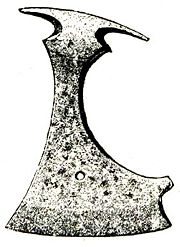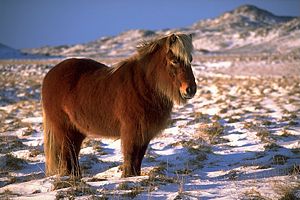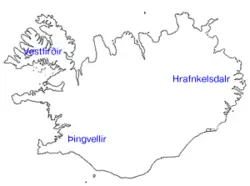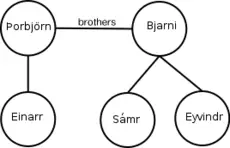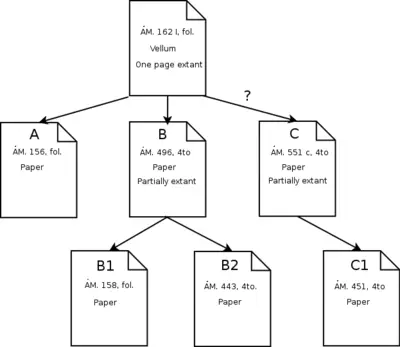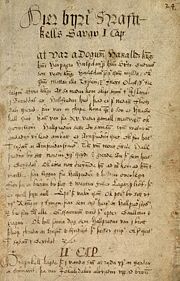
Hrafnkels saga (ňąrŐ•apnc…õls ňĆsaňź…£a) is one of the Icelanders' sagas. It tells of struggles between chieftains and farmers in the east of Iceland in the tenth century. The eponymous main character, Hrafnkell, starts out his career as a fearsome duelist and a dedicated worshipper of the god Freyr. After suffering defeat, humiliation, and the destruction of his temple, he becomes an atheist. His character changes and he becomes more peaceful in dealing with others. After gradually rebuilding his power base for several years, he achieves revenge against his enemies and lives out the rest of his life as a powerful and respected chieftain. The saga has been interpreted as the story of a man who arrives at the conclusion that the true basis of power does not lie in the favor of the gods, but in the loyalty of one's subordinates.
The saga remains widely read today and is appreciated for its logical structure, plausibility, and vivid characters. For these reasons, it has served as a test case in the dispute on the origins of the Icelandic sagas.
Synopsis
The saga tells the story of the Norwegian man Hallfre√įr, who becomes one of the original settlers of Iceland, arriving on the east coast around the year 900 with his teenage son, Hrafnkell, a promising young man. Hrafnkell has ambition and soon‚ÄĒwith the permission of his father‚ÄĒestablishes his own settlement. He selects an uninhabited valley for his farm and names it A√įalb√≥l ("Noble home"). The valley subsequently receives the name Hrafnkelsdalr ("Hrafnkell's valley").
Hrafnkell also had a large temple erected and performed lavish sacrificial ceremonies. He dedicated the best of his livestock to his patron deity, Freyr, including his favorite horse, Freyfaxi. He swore that he would kill anyone who rides Freyfaxi without permission. From his religious activities, Hrafnkell comes to be known as Freysgo√įi (Freyr's go√įi).
Hrafnkell longs for power and soon establishes himself as a chieftain by bullying people in neighboring valleys. He has a penchant for duels and never pays weregild (reparations) for anyone he kills.
The saga then introduces a complication. Einarr, a shepherd of Hrafnkell's, needs a ride to perform his duties, but every horse he approaches runs away from him except Freyfaxi. So he takes Freyfaxi and rides him for the day. But after the horse has been ridden it runs home to A√įalb√≥l and starts neighing. Upon seeing his horse dirty and wet with sweat, Hrafnkell realizes what has happened. He rides out with his axe and reluctantly kills Einarr to fulfill his oath.
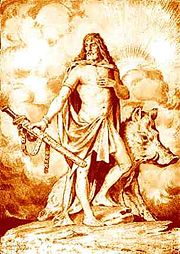
Einarr's father, √ěorbj√∂rn, upset at the death of his son, goes to Hrafnkell to seek weregild. Hrafnkell tells him that he pays weregild for no man. He does, however, think that this killing was among the worst he has done and is prepared to make some amends. He makes a seemingly favorable offer to √ěorbj√∂rn of taking care of him for the rest of his days.
√ěorbj√∂rn, however, wants nothing short of a formal settlement as between equals. Hrafnkell's rejects this notion, so √ěorbj√∂rn starts searching for ways to achieve satisfaction. The laws of the Icelandic Commonwealth guarantee every free man the same rights‚ÄĒbut since no central executive power exists, a common man would have difficulty in prosecuting a chieftain. He would generally need the support of another chieftain, both for the complicated legal maneuvering often necessary and, if successful at the assembly, for subsequently enforcing the verdict.
√ěorbj√∂rn tries to get the support of his brother, Bjarni, but the latter doesn't want to become involved in a dispute with the powerful Hrafnkell. √ěorbj√∂rn then goes to Bjarni's son, S√°mr. He, in turn, first advises √ěorbj√∂rn to accept Hrafnkell's offer but √ěorbj√∂rn remains adamant. S√°mr has no desire to join the conflict, but after his uncle becomes emotional he reluctantly agrees. S√°mr formally accepts the case from √ěorbj√∂rn so that he effectively becomes the plaintiff.
S√°mr starts preparing the case against Hrafnkell and summons him to the Al√ĺing the next summer. Hrafnkell regards the attempt as laughable. When S√°mr and √ěorbj√∂rn reach the assembly at √ěingvellir they quickly discover that no major chieftain wants to aid them. The emotional √ěorbj√∂rn now wants to give up, but S√°mr insists they must proceed, one way or the other.
By coincidence, S√°mr and √ěorbj√∂rn meet √ěorkell, a young adventurer from Vestfir√įir ("West fjords"). He sympathizes with their cause and helps them achieve the support of his brother, √ěorgeirr, a powerful chieftain. With √ěorgeirr's support, S√°mr competently prosecutes the case. The law finds Hrafnkell guilty, and he rides home to A√įalb√≥l. S√°mr now has the right to kill Hrafnkell and confiscate his property. One early morning, S√°mr, supported by √ěorgeirr and √ěorkell, arrives at A√įalb√≥l, surprising and capturing Hrafnkell while he sleeps.
S√°mr offers Hrafnkell two options: Execution on the spot, or to live as S√°mr's subordinate, stripped of his honor and most of his property. Hrafnkell chooses to live. √ěorkell cautions S√°mr that he will regret sparing Hrafnkell's life.
S√°mr subsequently takes up residence at A√įalb√≥l and invites the locals for a feast. They agree to accept him as their new chieftain.
Hrafnkell builds himself a new home in another valley. His spirits and ambition remain unbroken, and after a few years of hard work he has again established himself as a respectable farmer.
√ěorkell and √ěorgeirr decide to "deliver Freyfaxi to his owner" and push him off a cliff. They also set fire to Hrafnkell's temple. Upon hearing this, Hrafnkell remarks: "I think it is folly to have faith in gods," and he never performs another sacrifice. His manner improves and he becomes much gentler with his subordinates. In this way he gains popularity and loyalty.
After six years of peace, Hrafnkell decides the time for revenge has come. He receives news that S√°mr's brother, Eyvindr, is traveling close by with a few companions. He gathers his own men and goes to attack him. S√°mr gets word of the battle and immediately rides out with a small force to aid his brother. They arrive too late.
The next morning, Hrafnkell surprises S√°mr when he is asleep, offering him a similar choice to the one he had received from him six years before, with no weregild paid for Eyvindr. Like Hrafnkell, S√°mr also chooses to live. Hrafnkell then takes up residence at A√įalb√≥l, his old home, and resumes the duties of a chieftain.
S√°mr rides west and again seeks the support of √ěorkell and √ěorgeirr, but they tell him he has only himself to blame for his misfortune. He should have killed Hrafnkell when he had the chance. They will not support S√°mr in another struggle with Hrafnkell but offer him to move his residence to their region. He refuses and rides back home. S√°mr lives as Hrafnkell's subordinate for the rest of his days, never achieving revenge.
Hrafnkell, on the other hand, lives as a respected leader until he meets a peaceful end. His sons become chieftains after his day.
From writer to reader
Preservation
The author of Hrafnkels saga remains completely unidentified. The text does not name him; nor does any other extant source. He was, however, certainly an Icelander and probably lived near the area which serves as the setting for the saga's events.
The precise time of composition of the saga also remains unknown, but the late thirteenth century seems most likely. The oldest extant manuscript uses vellum from the first half of the fifteenth century, but unfortunately only one page remains. Paper copies made from the complete manuscript preserve the full text of the saga. The partially extant skin manuscript may well have copied the original composition directly. In any case, the saga seems well preserved, with little rewriting and few accidental errors.
One class of paper manuscripts, C and C1 in the diagram, contains a slightly different version of the saga with several, mostly minor, additions. Most scholars have considered it as derived from the same vellum manuscript as the others with additions from the author of Fljótsdæla saga. Thus they believe the shorter text closer to the original, and have given scant attention to the extended version.
Publishing history
P. G. Thorsen and Konr√°√į G√≠slason gave the saga its first publication, in Copenhagen, in 1839. Other important scholarly editions include those of J. Jakobsen in 1902‚Äď1903 and of J√≥n J√≥hannesson in 1950.
The saga has seen many popular editions and translations into a number of languages. The popular edition published by Halld√≥r Laxness in 1942, caused a stir as the first to use modern Icelandic spelling for a text in Old Icelandic. The edition's detractors rejected this approach as a perversion of the original text. Its supporters, in response, depicted the standardized Old Norse spelling as an artificial construct‚ÄĒno closer to the actual manuscripts than the modern spelling‚ÄĒand an unnecessary burden to the casual reader. The latter view won out and the sagas have since frequently appeared using modern spelling conventions.
Modern reception
Today, Hrafnkels saga remains one of the most widely read sagas. Readers especially appreciate it for its cohesive and logical story line; along with its shortness, these qualities make it an ideal first read for newcomers to the sagas. It has served as a standard text in Icelandic high schools and as an introductory text for students of Old Norse. Sigur√įur Nordal called it "one of the most perfect short novels in world literature."
Origins
Precisely the attributes which make Hrafnkels saga so accessible have served to make it an attractive target for different theories on the origins of the Icelandic sagas. Identical elements sometimes serve to support widely different theories.
History
Some commentators have seen the sagas as largely historical accounts, preserved orally for hundreds of years until committed to writing by faithful scribes. Scholars in the nineteenth century especially espoused this view; it largely went out of fashion in academia by around 1940, although many amateurs still hold to it.
Many see Hrafnkels saga as a prime example of accurately preserved oral history. They find the saga inherently plausible in that its characters have logical motivations and the results of their actions are realistic. The text has little supernatural content. It is short enough and cohesive enough for its oral preservation to be entirely plausible. Indeed the average modern reader can probably retell the story accurately after two or three readings.
But the historical interpretation ran into several problems. When compared with other sources on the same period, notably Landn√°mab√≥k, discrepancies were revealed. As one example, Landn√°mab√≥k tells us that Hrafnkell had a father named Hrafn, but the saga names him Hallfre√įr. The saga's treatment of the laws of the time also shows inconsistencies with reliable sources.
Literature
The historical inconsistencies and other difficulties led Sigur√įur Nordal to write his groundbreaking book Hrafnkatla, in 1940. He greatly expands upon previous criticism on the saga and draws on data from many areas to cast doubt on its historical veracity.
Aside from the conflicts with Landn√°mab√≥k and the laws of the time, Sigur√įur argues that the saga treats geographical facts incorrectly. He claims that the valleys used as the ostensible settings for the events of the story would never have allowed for as great a population as the saga assumes. He also states that the cliff near A√įalb√≥l, the alleged site of the killing of Freyfaxi, simply does not exist.
Sigur√įur sees the saga's convincing narrative and characters as evidence that a single brilliant author composed it. According to Sigur√įur the author cared little for historical accuracy, and insofar as he may have used any written historical sources, he changed them according to his own whim to fit the plot of the novella he wanted to write.
Folklore
Another school of thought regarding the origin of the sagas, which came into prominence in the second half of the twentieth century, emphasizes the elements of folklore and the oral survival of legends for an extended period of time.
In some ways, this marks a return to the old idea of oral preservation of the sagas, but the folklorists do not necessarily focus on historical accuracy. They apply modern research to determine which elements of a story seem likely to endure and which seem ephemeral. Theory suggests that core story lines of the sagas will preserve oral elements long-term, whereas one can expect details‚ÄĒsuch as the names of secondary characters‚ÄĒto change over the centuries.
The Icelandic scholar √ďskar Halld√≥rsson wrote a short book on Hrafnkels saga criticizing Sigur√įur Nordal's previous work. According to √ďskar such details as an incorrect name for Hrafnkell's father do not constitute valid evidence for the view of the saga as a thirteenth century fiction. On the contrary, √ďskar takes this as confirmation that the story of Hrafnkell survived independently in the east of Iceland, and changed in unimportant details, long after the composition of Landn√°mab√≥k.
√ďskar traces the story of Freyfaxi back to horse-worship among Indo-European peoples, and in his opinion such mythic or folkloric themes strengthen the case for the oral preservation of elements of Hrafnkels saga since heathen times.
Recent views
The controversy on Hrafnkels saga remains unsettled. In a 1988 book, Hermann P√°lsson again completely dismisses the idea of an oral tradition and seeks the origins of the saga in medieval European ideas. In a departure from previous scholarship, Hermann based his research on the extended version of the saga.
J√≥n Hnefill A√įalsteinsson, in his 2000 book on the saga, emphasizes its heathen religious elements. While acknowledging that a large part of the story line probably represents thirteenth century fiction, J√≥n Hnefill finds evidence of an oral tradition in such aspects of the story as Hrafnkell's sacrifices and the behavior of Freyfaxi.
Jónas Kristjánsson, in his 1988 work on the sagas, summed up the argument on Hrafnkels saga when he said that the great interest in it "has led to deeper consideration of other texts … It has become a test-case, the classic example, in the discussion of relations between unsophisticated oral story-telling and learned well-read authors, between inherited pragmatic attitudes and imported Christian ethics."
ReferencesISBN links support NWE through referral fees
- A√įalsteinsson, Jon Hnefill. √ě√° hneggja√įi Freyfaxi. Reykjav√≠k: H√°sk√≥la√ļtg√°fan, 2000. ISBN 9979544317
- Halld√≥rsson, Oskar. Uppruni og √ĺema Hrafnkels s√∂gu. Reykjav√≠k: Hi√į √≠slenska b√≥kmenntaf√©lag, 1976.
- Halldórsson, Oskar. The origin and theme of Hrafnkels saga. In John Tucker, ed. Sagas of the Icelanders: A Book of Essays. New York: Garland, 1989. ISBN 0824083873
- J√≥hannesson, Jon, ed. √ćslenzk fornrit XI‚ÄĒAustfir√įinga s«ęgur. Reykjav√≠k: Hi√į √≠slenzka fornritaf√©lag, 1950.
- Kristj√°nsson, Jonas. Eddas and Sagas. Iceland's Medieval Literature. Translated by Peter Foote. Reykjav√≠k: Hi√į √≠slenska b√≥kmenntaf√©lag, 1988.
- Nordal, Sigur√įur Hrafnkatla. Reykjav√≠k: Sigur√įur Nordal, 1940.
- Nordal, Sigur√įur Hrafnkels saga Freysgo√įa: A Study. Translated by R. George Thomas. Cardiff: University of Wales, 1958.
- Palsson, Hermann. Mannfr√¶√įi Hrafnkels s√∂gu og frum√ĺ√¶ttir. Reykjav√≠k: B√≥ka√ļtg√°fa Menningarsj√≥√įs, 1988.
English translations
- Coles, John (translator) (1882). "The Story of Hrafnkell, Frey's Priest" in Summer Travellings in Iceland pp. 230-49. London.
- Jones, Gwyn (translator) (1935). "Hrafnkel Freysgodi's Saga" in Four Icelandic Sagas pp. 37‚Äď61. New York.
- McGaillard, John C (translator) (1956). "Hrafnkel's saga" in World Masterpieces pp. 512-32. New York.
- Jones, Gwyn (translator) (1961). "Hrafnkel the Priest of Frey" in Eirik the Red and other Icelandic Sagas pp. 89‚Äď125. Oxford.
- Hermann P√°lsson (translator) (1971). Hrafnkel's saga and other Icelandic stories. Penguin.
- Gunnell, Terry (translator) (1997). "The Saga of Hrafnkel Frey's Godi" in The Complete Sagas of Icelanders vol. V, pp. 261-81. Leifur Eiríksson Publishing.
External links
All links retrieved July 19, 2024.
- Full text of the saga in the original language.
- Full text and translations into several languages at the Icelandic Saga Database.
| Sagas of Icelanders |
|---|
|
Bandamanna saga¬†| B√°r√įar saga Sn√¶fells√°ss¬†| Bjarnar saga H√≠tdŇďlakappa¬†| Brennu-Nj√°ls saga¬†| Droplaugarsona saga¬†| Egils saga Skalla-Gr√≠mssonar¬†| Eir√≠ks saga rau√įa¬†| Eyrbyggja saga¬†| F√¶reyinga saga¬†| Finnboga saga ramma¬†| Flj√≥tsd√¶la saga¬†| Fl√≥amanna saga¬†| F√≥stbrŇď√įra saga¬†| G√≠sla saga S√ļrssonar¬†| Grettis saga¬†| GrŇďnlendinga saga¬†| Gull-√ě√≥ris saga¬†| Gunnars saga Keldugn√ļpsf√≠fls¬†| Gunnlaugs saga ormstungu¬†| Hallfre√įar saga¬†| Har√įar saga ok H√≥lmverja¬†| H√°var√įar saga √ćsfir√įings¬†| Hei√įarv√≠ga saga¬†| Hrafnkels saga¬†| Hrana saga hrings¬†| H√¶nsna-√ě√≥ris saga¬†| Kjalnesinga saga¬†| Korm√°ks saga¬†| Kr√≥ka-Refs saga¬†| Laxd√¶la saga¬†| Lj√≥svetninga saga¬†| √Ėlkofra saga| ReykdŇďla saga ok V√≠ga-Sk√ļtu¬†| SvarfdŇďla saga¬†| √ěorsteins saga hv√≠ta¬†| √ěorsteins saga S√≠√įu-Hallssonar¬†| √ě√≥r√įar saga hre√įu¬†| Valla-Lj√≥ts saga¬†| V√°pnfir√įinga saga¬†| VatnsdŇďla saga¬†| V√≠ga-Gl√ļms saga¬†| V√≠glundar saga¬† |
Credits
New World Encyclopedia writers and editors rewrote and completed the Wikipedia article in accordance with New World Encyclopedia standards. This article abides by terms of the Creative Commons CC-by-sa 3.0 License (CC-by-sa), which may be used and disseminated with proper attribution. Credit is due under the terms of this license that can reference both the New World Encyclopedia contributors and the selfless volunteer contributors of the Wikimedia Foundation. To cite this article click here for a list of acceptable citing formats.The history of earlier contributions by wikipedians is accessible to researchers here:
The history of this article since it was imported to New World Encyclopedia:
Note: Some restrictions may apply to use of individual images which are separately licensed.
